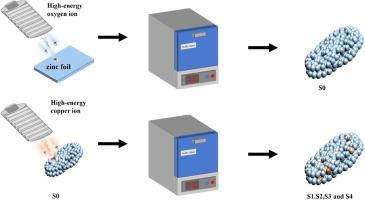离子注入工程Cu+掺杂ZnO纳米结构材料:光催化抗菌活性和降解有机化合物
IF 6.9
2区 材料科学
Q2 CHEMISTRY, PHYSICAL
引用次数: 0
摘要
本研究采用离子注入技术制备Cu-ZnO纳米结构材料。值得注意的是,该技术不仅可以合成ZnO衬底本身,还可以精确地将Cu离子掺杂到ZnO晶格中。通过这种集成策略,有效地展示了离子注入的独特优势。研究了甲基橙在紫外线(UV)和可见光(LED)照射下的抗菌性能,以及甲基橙在可见光下的降解性能。XRD和XPS分析证实了Cu离子在ZnO晶格中的取代掺杂。紫外-可见吸收光谱显示出较宽的光学吸收范围。对效果最好的样品进行抑菌试验,紫外照射(1 min)和可见光照射(60min)对大肠杆菌的灭活率分别为90.60 %和73.41 %。在紫外光照射下,其杀菌机制主要是ZnO光致活性氧(ROS),而在可见光下,其杀菌机制主要依赖于Cu2+和Zn2+离子释放的协同作用以及窄带隙介导的ROS生成。光催化实验表明,Cu-ZnO在可见光下对甲基橙的降解率比纯ZnO提高了1.3倍,在60 min内的去除率达到52.7 %。这种增强归因于Cu离子掺杂诱导的光生电子空穴对的有效分离。本研究为不同光照条件下离子注入技术的工程光催化剂研究奠定了实验基础。本文章由计算机程序翻译,如有差异,请以英文原文为准。


Ion implantation engineered Cu+ doped ZnO nanostructured materials: photocatalytic antibacterial activity and degradation of organic compounds
In this study, ion implantation technology was utilized to fabricate Cu-ZnO nanostructured materials. Notably, this technique enabled not only the synthesis of the ZnO substrate itself but also the precise doping of Cu ions into the ZnO lattice. Through this integrated strategy, the unique advantages of ion implantation were effectively demonstrated. The antibacterial performance under ultraviolet (UV) and visible light (LED) irradiation, along with the performance of methyl orange degradation under visible light, was investigated. XRD and XPS analyses confirmed the substitutional doping of Cu ions into the ZnO lattice. UV–Vis absorption spectroscopy indicated an extended optical absorption range. Antibacterial tests on the sample with the best performance revealed inactivation rates of 90.60 % and 73.41 % for Escherichia coli under UV irradiation (1 min) and visible light exposure (60 min), respectively. Under UV irradiation, the bactericidal mechanism is dominated by ZnO intrinsic photoinduced reactive oxygen species (ROS), whereas under visible light, it relies on the synergistic effects of Cu2+ and Zn2+ ion release and narrow-bandgap-mediated ROS generation. Photocatalytic experiments showed that Cu-ZnO achieved a 1.3-fold increase in methyl orange degradation rate compared to pure ZnO under visible light, with a 52.7 % removal rate within 60 min. This enhancement was attributed to the effective separation of photogenerated electron-hole pairs induced by Cu ions doping. This study establishes an experimental basis for engineering photocatalysts via ion implantation technology under diverse illumination conditions.
求助全文
通过发布文献求助,成功后即可免费获取论文全文。
去求助
来源期刊

Applied Surface Science
工程技术-材料科学:膜
CiteScore
12.50
自引率
7.50%
发文量
3393
审稿时长
67 days
期刊介绍:
Applied Surface Science covers topics contributing to a better understanding of surfaces, interfaces, nanostructures and their applications. The journal is concerned with scientific research on the atomic and molecular level of material properties determined with specific surface analytical techniques and/or computational methods, as well as the processing of such structures.
 求助内容:
求助内容: 应助结果提醒方式:
应助结果提醒方式:


